The number of rounds of golf played in the United States in 2020 climbed 13.9 percent as people flocked to courses to escape COVID pandemic.
Consider this more evidence that you should book your tee times early: Golf Datatech reported Monday that total rounds of golf played in the United States in 2020 were up 13.9 percent over 2019, largely due to golfers seeking recreational opportunities during the COVID-19 pandemic.
That annual increase in rounds set a record for percentage increase since Golf Datatech started tracking rounds played in 1998. The previous record had been a 5.7-percent surge in rounds played in 2012.
Retail sales of golf equipment also surged in 2020, Golf Datatech reported, with $2.81 billion in revenue. That was a 10.1 percent increase over 2019. It gave 2020 the third-highest annual total since Golf Datatech began tracking the industry, trailing only $2.91 billion in 2008 and $2.87 billion in 2007.
“While the global pandemic wreaked havoc on many segments of our economy, the golf industry experienced a significant boost in rounds played and equipment sales,” John Krzynowek, a partner at Golf Datatech, said in a release announcing the surge in rounds played. “On the equipment side, sales increased by low single digits in both 2018 and 2019, but the double-digit gains in 2020 can only be attributed to the pandemic and golf being a respite for so many.”
[listicle id=778057023]
Those year-long gains happened despite golf being shut down in many states as the pandemic took hold of the nation in March and April. Rounds played in March fell 8.5 percent versus the same period of 2019, and rounds in April were down 42.2 percent, based on reports by Golf Datatech and the National Golf Foundation.
Then came the surge, as golf was recognized as a relatively safe escape during the pandemic. Rounds played were up 6.2 percent in May of 2020 versus May of 2019, followed by gains of 13.9 percent in June, 19.7 percent in July, 20.6 percent in August, 25.5 percent in September, 32.2 percent in October and 57.5 percent in November. Information for December was released Monday, with rounds played for the month up 37 percent over December of 2019, which no doubt was helped by good weather in winter golf settings such as Florida, Arizona and California.
“Golf Datatech started collecting and projecting monthly rounds-played data in January 1998 and has been the industry’s exclusive monthly metric since that time,” Krzynowek said. “We’ve never seen an annual increase remotely close to this, as the previous record increase occurred in 2012, a year when we had nearly perfect weather across much of the United States and rounds played grew by 5.7 percent. While there is no doubt that the pandemic provided a positive jolt of energy to the golf business in 2020, a warmer and drier climate across broad swaths of the U.S. also generated more potential tee times, which the golf community passionately consumed…and continued to ask for more.”
Increases in rounds played varied greatly by region. The area defined as West North Central by Golf Datatech – Missouri, Kansas, Nebraska, Iowa, Minnesota, South Dakota and North Dakota – saw a 23.1-percent increase in rounds played in 2020 over 2019. That compares to only a 4.8-percent annual rise – the smallest of any region in the U.S. – in the Pacific Region of California, Oregon and Washington.
It’s important to note that gains aren’t spread evenly across the industry. Some resorts that rely on air travel have been hit particularly hard in the wake of the pandemic as golfers choose to drive to more local and regional destinations. And the percentage increases in rounds played don’t necessarily mean equal increase in revenue, as many clubs have lost income tied to food and beverage as well as events such as weddings.
On the retail side, as well, gains were not even across categories. While revenue for clubs, balls and other hard goods soared, with many equipment makers struggling to fill demand as inventories dwindled, some soft goods categories lagged in sales.
For example, Golf Datatech reported that sales of apparel dropped 14.2 percent in 2020 versus 2019, largely because access to green-grass pro shops was limited by the pandemic and more public-access golfers were booking rounds online. The loss of rounds played at resorts that rely on air travel also diminished total apparel sales, as fewer players were onsite to purchase logo merchandise. Meanwhile, online sales of apparel rose, and despite the overall annual drop, the last two months of 2020 saw an 11 percent increase in apparel sales versus the same period in 2019.
Across the board, Golf Datatech reported that total consumer demand across the golf industry as measured by dollars spent increased 3.2 percent versus 2019.
“Given the state of the golf economy in late spring, anything in positive territory had to be considered a big win,” Krzynowek said, “and December data continues to impress and suggest the business may still have room to run in early 2021. …
“Golf has fared better than many other U.S. industries during the pandemic, as on-course and off-course facilities effectively adapted their operations to accommodate customers while adhering to CDC, local and national health departments guidelines. Overall, the golf industry can be proud of how it has handled the adversity brought on by the pandemic thus far but must always be aware that until a vaccine is distributed, and broad-based immunity is present, we must all continue to be on guard.”
[lawrence-related id=778071575,778029859]










